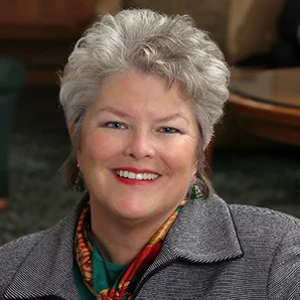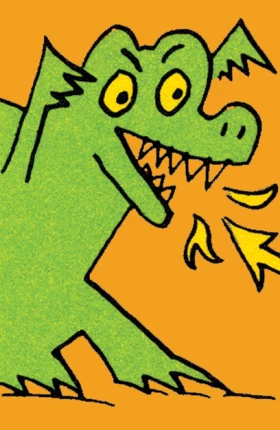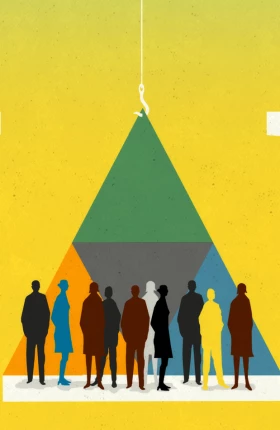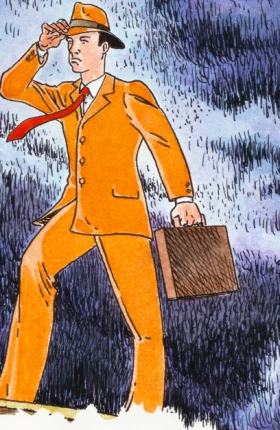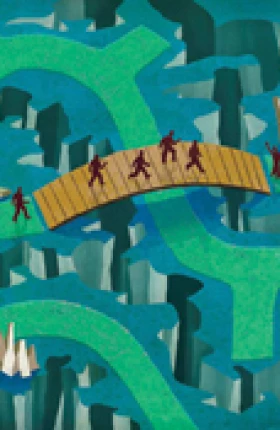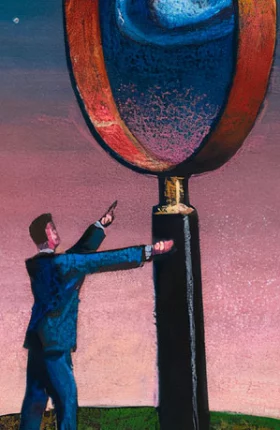Battling the Monster: The Need to Think and Behave Differently
I’m crazy for chocolate—dark chocolate, that is. Some years ago, a friend of mine sent me, from California, a two-pound box of See’s dark chocolate nuts and chews. I was in heaven! As I was oohing and aahing over the box and generally making a fool of myself, my daughter Jennifer, then age three, joined in the excitement. This was a bad sign. If she was excited it was because she expected to share in my newly acquired bounty. Clearly the only way I could get rid of her was to share, so I gave her a piece and sent her to bed. Then I had “just a few” pieces for myself, and went to bed.
Later that night, we had one of those glorious storms so common to Alabama—thunder, lightning, wind, and rain. I got up in the dark and went from room to room, closing the open windows. As I did, I stepped on something crunchy on the hallway. When I turned on the light, I saw that the floor was covered with little round pieces of dark brown paper. I followed the trail of candy wrappers just like the Yellow Brick Road, only instead of the Emerald City being at the end, I found a totally empty box of See’s candy! I was stunned. I thought, “She’s only three, for goodness sake! How could she possibly polish off two pounds of chocolate?”
I found Jennifer sound asleep in her bed, looking angelic. (Actually, I think she was in a glucose stupor; in any case, she was out for the count.) The next morning, I confronted her.
“Jennifer Duck, you ate all my candy!”
“No I didn’t,” she immediately replied with a look of earnestness and fear on her face.
“Oh yes you did.” I said. “Only two people live here—you and me—and I didn’t do it!”
She hung her head. Then, quietly, she mumbled, “I wish I had a baby brother!”
I’ve never forgotten that incident, much to Jennifer’s chagrin—not because of my great chocolate loss, but because Jennifer’s response was so to the point. We all have a natural desire to find someone else to blame whenever we’re caught doing something wrong or found lacking. I know only too well how she felt. When I realize I have forgotten to fulfill a commitment—whether it’s to send a document, to call someone who has asked for some help before a meeting, or to schedule that lunch I’ve been promising a friend—I feel bad. All too often, I look for someone or some circumstance or event that will excuse or justify my behavior. At least I’ve learned to do this silently and to stop myself once I realize what I’m doing. I recount this story about my daughter because it exemplifies a central realization of change, a time when we must say to ourselves, “I need to behave differently.” We may also need to think differently, to take on a different perspective (or several), to practice new skills, to extend ourselves in new and often demanding ways.
To accomplish change of this kind takes courage. Not the kind of courage we hear about in the news: “Man Saves Child from Sure Death” or “Woman Quells Riot Single-handedly.” No, this kind of courage doesn’t make headlines. It’s a personal struggle that we see as mundane. Without taking away any credit from the heroes behind those headlines, I would suggest that it is an even greater and more difficult act of heroism to change ourselves. When people who have performed bravely in dramatic situations are interviewed, they say something like, “It was pure instinct. I’m no hero.” Or, in the case of firefighters, police, and similar professionals, “This is what we’re trained for. I was just doing my job.” When people who act as change agents in companies are interviewed, they often say, “If I’d known then what I know now, I don’t know if I would have signed up for this.” Or, “This change initiative was like going on a diet, giving up drinking, and quitting smoking—all at the same time. I’m sure glad it’s over.” Or, “I’ve never worked so hard or learned so much.” Or, “It was the most exhilarating and memorable time of my entire life.”
My Experience with the Monster
I have come to know and understand the change monster—my term for all the human issues that swirl around change—both personally and professionally. As a senior vice president with The Boston Consulting Group (BCG), I’ve been involved with many companies going through major change. I’ve helped senior executives and scores of managers through mergers, reengineering, and strategic transformations. It is fascinating work because the business stakes are high and the human dynamics are as complex and as gripping as any stage play or Hollywood melodrama.
Before I joined BCG, I experienced firsthand what it is like to live through a fundamental change. I was working as a middle manager at a savings and loan institution that, for several nerve-wracking months, teetered on the brink of bankruptcy. The management tried all kinds of tactics and tricks to salvage the business, but to no avail; finally, we went belly-up, were taken over by the Feds, and became part of the Resolution Trust Corporation. The situation wasn’t pretty and the process wasn’t fun. By the time all was said and done, I—along with about 30 percent of the workforce—got the boot. I will never forget the roller coaster of emotions we all experienced—the slow grinding climbs toward small successes, the sudden plunges toward disaster. Nor will I forget the different ways that my colleagues manifested their emotions. Some screamed bloody murder, some were silent and rode with white knuckles all the way, some jumped ship with no place to land; a few seemed to love the ride and all the drama that accompanied it. I was my first all-out battle with the corporate change monster.
My interest in change, however, predates that experience; in fact, it goes back to my childhood. I have always been intrigued by what people do and why. I’m often amazed at some action and immediately set to wondering, “What was he thinking?” Or, “What drove her to do that?” Figuring out group behavior can be an enthralling puzzle. What made them respond that way? How could that behavior have been predicted or altered? These have been burning questions for me for as long as I can remember.
To try to answer these questions, I followed a rather unusual path of formal and informal study. I started out as an artist, majoring in sculpture and figure drawing. Art is about observation and empathy, about being able to translate what one has observed and sensed into a tangible work that provokes an emotional response in the viewer. At its best, art makes a powerfully intimate connection between artist and viewer—a connection that is both personal and universal. Wouldn’t it be wonderful if our work life could punctuated by moments of connection like those we experience with art? Wouldn’t it be wonderful if we all understood that creating such moments is part of our job?
After receiving my degree, I first taught art to students in grades one through twelve, and then went for my master’s degree in art education at Pratt Institute in Brooklyn. While there, I also worked in the undergraduate Art Education department, supervising student teachers. I was trying to help them figure out how to teach art in the New York City public school system. Believe me, they weren’t interested in art theory; they wanted survival tactics, so I went for anything that was practical and made sense. In our sessions together, we didn’t discuss art. We discussed emotions and the human dynamics that were ricocheting around them and within them. Our discussions were candid searches that focused on trying to understand what was happening and how to bring some positive outcomes to all involved. We found transactional analysis (the study of transactions within and between people) to be particularly useful in explaining the forces that shape individual behavior, how norms are formed for groups, and how ideas for guiding interactions in the classroom can be stimulated. I later became certified as a transactional analyst.
It took me some years to see and validate that the emotional experience of change for individuals is similar to that of organizations—even organizations of very different types. After earning my degree from Pratt, I spent six years in the corporate world, and then—after getting the boot from S&L—I founded my own consulting firm. Early on, I was working with three very different clients—a consumer goods company, a defense contractor, and the emergency room staff of a large metropolitan hospital—all of whom were confronted with different issues. The emergency room docs bemoaned “the Saturday night knife-and-gun club,” which filled the hospital with critically wounded patients every weekend and turned the emergency room into a nightmare. The hospital administrators, meanwhile, were trying to figure out how to improve costs and reduce doctor turnover. The defense contractors were on the end of the spectrum. They were trying to determine the best way to improve their “kill rates” for specific weapons. Neither group, however, match the stress and earnestness of my clients at the third company—the marketers who were searching for the best way to improve the market share for their fading sugared cereal.
One day, during a meeting with the emergency room staff, I thought to myself, “They sound a lot like the defense guys.” This struck me as odd. Later that week, I realized that some of the work I was doing with the defense contractor would also be helpful to my clients at the cereal company. These correlations were intriguing, and I started to look for commonalities, patterns, and dissimilarities. I wanted to know whether companies in different industries, dealing with different issues, always had so much in common. Was the fact that all of them were going through radical change the common denominator? Are human beings so much alike that our “humanness” overrides other factors?
As I watched, analyzed, and probed during the subsequent months, the answer to both questions became more and more clear: Yes. The definition of the word “phenomenon” perfectly describes what I was experiencing: “That which appears real to the senses, regardless of whether its underlying experience is proved or its nature understood.” I was convinced that the same phenomenon was at work in all three situations. I then hypothesized the if people—individually and collectively—experience a common pattern when they go through major change, and if that pattern is clearly defined and understood, then it could be managed or, at least, guided.
Over the next several years, I developed a rudimentary framework for what I started to think of as the “Change Curve.” I first applied it when I was retained as a consultant by Ray Alvarez, General Manager of Micro Switch, a division of Honeywell. The company—which makes small sensors, controls, and switches for industrial, space, and military applications—had been founded in 1937 and purchased by Honeywell in 1950. For decades, Honeywell left Micro Switch pretty much alone. As thanks for this autonomy, the managers sent fat profits “up the river,” as they called it, to corporate headquarters in Minneapolis. Then the market moved toward a new type of electronic switches, but Micro Switch was slow to follow. In addition, Honeywell started diversifying. Companies in growth businesses, such as computer hardware, software, and peripherals, were purchased. The corporation came to rely on Micro Switch’s profits to help fund the acquisitions, and the management of Micro Switch felt great pride in being a cash cow for corporate. Over the years, the Micro Switch management slowed their investment in the division and continued to raise prices, cut costs, squeeze service, and starve R&D to keep those profits high. Within a few years, Micro Switch was deep in Stagnation. Key accounts were lost. An overseas company began to snatch market share; the Micro Switch managers, who had considered this competitor as beneath notice, now saw it as invincible. The corporate executives of Honeywell were divided about whether to sell or retain Micro Switch. They decided to bring in an experienced manager—a Honeywell veteran named Ray (Ramon) Alvarez—to turn things around.
When I started working with Ray and his management team, the division was mired in Stagnation. Together, we progressed through the phases that I now see so clearly as typical of every major change: Stagnation, Preparation, Implementation, Determination, and Fruition. For Micro Switch, the process took about three years. But many companies—especially technology and Internet companies—must accomplish their changes much faster, sometimes in a matter of months.
Emotions Are Data
Based on all these experiences—as a manager, a consultant, an observer of behavior, a mother, an artist, and a teacher—I have come to believe strongly that the emotional aspects of change are not just important, they are vital. If leaders don’t take into consideration the emotional data, all the operational information and numeric data in the world won’t be enough to turn around a company. Changing an organization is inherently and inescapably an emotional human process. When I say emotional, I’m not talking about fleeting moods or surface feelings. I’m talking about the major states of emotional beings: fear, curiosity, exhaustion, loyalty, paranoia, depression, optimism, rage, revelation, delight, and love.
When an organization embarks on a change of any magnitude, its leaders tend to think that they are facing a series of operational tasks that will, if executed successfully, result in a new state of being. They don’t realize that they will also have to face an onslaught of emotions and human dynamics. I have come to understand that emotions truly are data and have just as much relevance as data on sales, profits, or any other “tangible” aspect of organizational performance. I also believe that it is possible to address emotional data with rigor and rationality—to identify and define emotions, analyze how they affect performance, and develop strategies and tactics to address them.
Not only is it possible to gather and address the emotional data, it is imperative. Dealing with the change monster is so critical to the success or failure of a change initiative that it is not only the legitimate purview of leaders, it is their major challenge and responsibility. And when I say leaders I am not talking not just about the handful of executives at the very top of an organization. I’m referring to the many people who lead divisions and business units, departments and groups, teams and task forces. I know from experience that too many leaders are slow to identify the human issues, fail to recognize their significance, and are very reluctant to confront them directly.
Three Essentials of Change Management
Over the years, I have continuously refined the Change Curve and my understanding of the change monster. When I joined BCG, I was able to validate that the change curve essentially applies universally—thanks to the corroborating data and experience of my colleagues who work with companies of every description, worldwide. We have found that the phases of the Change Curve described in this book are valid in an extremely wide range of companies, industries and geographies. While the experience of each individual company is always unique, the phases and principles of change are the same. How long those phases last, whether or not they are repeated and what the velocity of movement is within those phases will vary depending on the leadership and the intensity of the changes required.
The Change Curve applies to fundamental change efforts of virtually every kind of entity—nonprofit and charitable organizations; educational and religious institutions; government agencies; community organizations, associations, and clubs; and families. Once you begin to recognize the phases of change and understand the dynamics of each one, the Change Curve becomes visible—and useful—in almost every field of activity.
I do not argue that managing change for any of these entities is only about addressing the human dynamics. Rather it is one of three essential elements required for successful change:
1. Strategy: a passionate belief in where you’re going.The strategy must be sound and the commitment unflinching. The more clearly the strategy can be articulated and the more easily it can be understood and translated into action, the better
2. Execution: good, basic management. A successful transition requires the same good management practices that are fundamental to running an effective organization during times of stability and “normal” operation (if there is such a thing). Good management becomes absolutely indispensable, however, when an organization is undergoing radical change.
3. Managing the monster requires a heightened sensitivity to the emotional and behavioral issues during change, and a willingness to address them. I assume that readers have already mastered the first two elements or know where to go for help in doing so. This book focuses almost exclusively on the third element.
The Structure of the Book
I have structured the book around the five phases that make up the Change Curve. To illustrate those phases, I describe how two companies and their leaders go through major change. The first company is Honeywell Micro Switch and its leader Ray Alvarez. I chose to tell this story because it encompasses so many challenges, and the initiatives taken were tremendously successful. Also, I wanted to highlight a real person, a leader who is not famous or overexposed but who worked hard and figured out how to overcome the monsters he encountered. Ray began the Micro Switch initiative as a seasoned leader who had led two earlier transformations and he had a deep understanding of the emotional aspects of change. Even so, he endured an intense personal odyssey which was a challenging and difficult process for the organization and for Ray.
Because Ray exemplifies a “right” way to go about a change process, his story is undisguised. To introduce many of the things that can go wrong in a change effort, I have created a merger of two pharmaceutical companies—Commando Drug and Venerable BV—both of which find themselves in different types of Stagnation. The story focuses on the process of creating a new, single entity called CoVen. The research and development group is led by Dr. Marco Trask, who, unlike Ray, has little experience in change management and pays scant attention to the human dynamics that accompany any merger. During the course of the year-long initiative, Marco confronts the change monster in many unexpected forms. He undergoes a personal transformation that ultimately helps him achieve success for his organization and himself. This case and the characters are based on my work with several different clients, in several industries, as well as the work of my colleagues at BCG. So while this merger story is fiction, it is true to life.
In addition to these stories, I will include references to other companies involved in a variety of types of change efforts—including e-start-up, deregulation, privatization, and reengineering—and to executives, managers, and consultants who have lived through those changes and done battle with the monster.
It’s Not All Pain
Mark Twain once wrote, “When in doubt tell the truth.” I would be fibbing if I told you that if you just follow my guidelines and learn the phases of the Change Curve, you’ll slay the change monster instantly and achieve your goals easily and painlessly. However, I do believe that an understanding of the phenomenon of the Change Curve will make the changes you face easier and less confusing, and help you achieve the desired results sooner.
I would also be fibbing if I said that change involves only pain and difficulty. It doesn’t. The change process may be complicated, time-consuming, and filled with truths you might wish you never had to face, but it can also be the most satisfying, challenging, and spirited work of a career. I approach every new organizational change engagement with both excitement and trepidation. I know that no one involved, regardless of position, will emerge from it without undergoing some personal change. You will have some of your assumptions challenged and will find areas of strength and weakness you did not know existed. Relationships with others will open out or narrow down. You will discover pockets of personal ignorance and wisdom and will learn a thousand new things about yourself and others.
As my mama often said to me when I was obsessing about some teenage crisis, “Well, Jeanie, living through this may be chaotic and trying, but it’ll never be boring!” I didn’t particularly appreciate that pearl of wisdom at the time, but it gave me a different perspective on the next crisis and made it a little easier to get through. I hope that what I offer here can be equally useful.
You can purchase The Change Monster online at Amazon or at Barnes & Noble .
Excerpted from The Change Monster: The Human Forces That Fuel or Foil Corporate Transformation & Change by Jeanie Daniel Duck, by arrangement with Crown Business, a member of the Crown Publishing Group, Random House, Inc. Copyright © 2001, Jeanie Daniel Duck.
